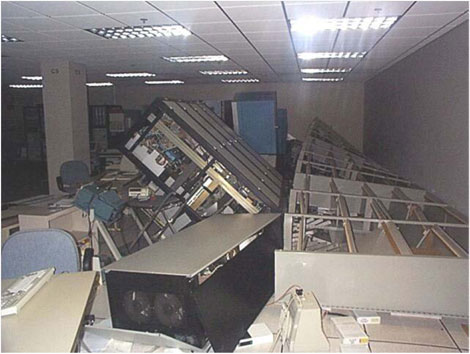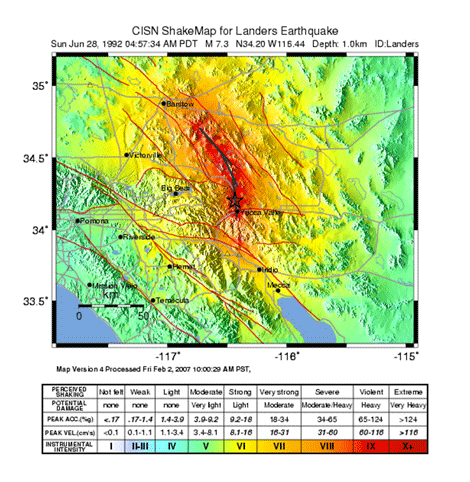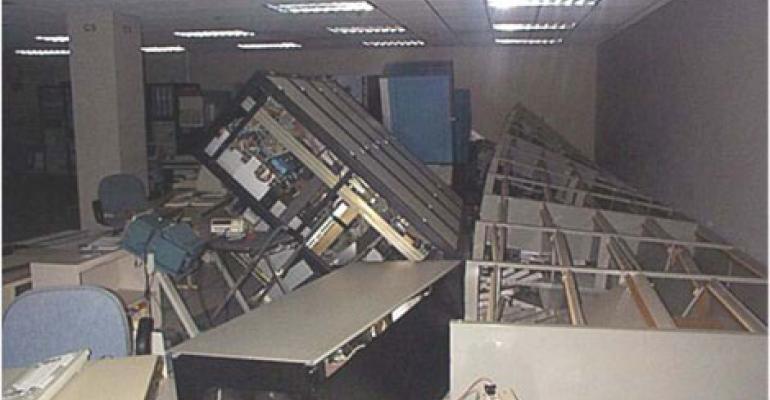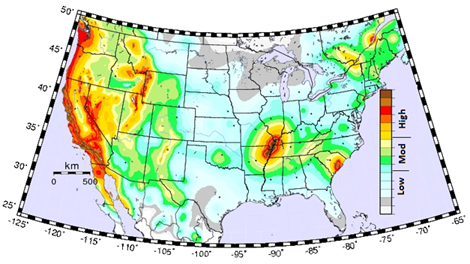Keith Porter is PE, PhD, Principal, SPA Risk LLC, in Denver. Co-author Molly Latham, CBCP, MBCI, President, Association of Contingency Planners, which is located Los Angeles, also contributed to this article.
 KEITH PORTER
KEITH PORTERSPA Risk
Unlike the seasonal disasters that strike "tornado alley" or the U.S. Gulf Coast, in earthquake country, it’s always earthquake season. Earthquakes have no preferred time of day, tidal stage, or (as yet) predictable indicator. We can, however, estimate their probabilities. In Northern California, for instance, there is a 63% chance of a magnitude 6.7 earthquake occurring in the next 30 years, a 67% chance in Southern California, and a 99.7% chance in California as a whole. U.S. earthquake risk is not limited to California. By one standard of the Federal Emergency Management Agency, 38 US states have regions of moderate to high seismic hazard and 60% of the U.S. population lives in an area of moderate to high seismic risk, so chances are good that any particular U.S. building is in earthquake country. When it comes to data centers in earthquake country, we know two things:
- The site will be affected by an earthquake
- The earthquake could happen tomorrow
Earthquakes render data centers inoperative without warning by damaging the building, the equipment inside, and the lifelines that serve it. The most likely cause of earthquake failure results from the seismic installation of equipment and architectural elements such as raised floors and suspended ceilings.
Equipment at Risk
Even if the building is modern and meets the current code, it is common for at least some equipment to lack sufficient seismic restraint. In most cases, seismic restraint can be added fairly easily and relatively inexpensively, making the building substantially more resilient.

Figure 2. Overturned computer and communication racks. Seismic restraint helps to prevent this kind of damage.
Certain kinds of older buildings tend to be vulnerable to red tagging (being declared uninhabitable), especially un-reinforced masonry (URM) buildings and older concrete-frame buildings. In 1986, California enacted a law that required most local jurisdictions to establish a URM loss reduction program, but as of 2006 (the most recent year for which data are available), 25% of URM buildings were in jurisdictions without a mandatory retrofit program, and 30% of URM buildings in existence in 1986 have not been retrofitted nor demolished.
Efforts to address the hazards posed by older concrete frame buildings are still in their infancy. It is important to remember that if a building met code when it was built, it might never have been strengthened, and might not meet current code requirements. Remediating a bad building can be very costly, but if one knows the building is seismically vulnerable, one can at least consider long-term plans to transfer operations to a better building.
Community Impacts: More than Your Facility
Even if the building and equipment are seismically resistant, lifeline failure in earthquakes is common. For example, many critical facilities rely on an HVAC system that uses evaporative cooling, using water from the community water supply. If that supply is disrupted, an otherwise undamaged facility may be inoperative for days or weeks. The same is true of commercial power: a large earthquake can cause a temporary blackout over multiple states, and may result in longer-term outages closer to the strong shaking. In a large southern California earthquake, for example, most customers in four strongly shaken counties are expected to be without power for more than a week, and water supply in the strongest-shaken areas could be interrupted for a few days or several weeks.
Having a backup facility reduces the chance that an earthquake will interrupt operations. But if the backup is located close to the primary site, both sites can be rendered inoperative by the same earthquake. The closer they are, the more likely is a common-cause failure: they are more likely to both be strongly shaken; or the same damaged lifeline may serve both sites; or the same fire could require both to be evacuated. There are obvious tradeoffs between proximity and risk. A closer backup generally means lower logistical costs, but it also means greater likelihood of a common-cause failure. Depending on where the two sites are, “close” might be tens of miles or more.

Figure 3. A single California earthquake can strongly shake a area 100 miles wide or more, hence the need to site backups as far from the primary site as practical. Click to enlarge graphic.
Applying Risk Analysis
These and other causes of operational failure can be anticipated and remediated. One can even apply engineering risk analysis to the problem. Experts can calculate the chance of each cause of failure, the occurrence probability of every earthquake that could affect the facilities, and the chance that an earthquake will render the facility inoperative for a particular duration after the earthquake. The same calculation can be performed assuming that certain fixes are undertaken, such as anchoring equipment, adding emergency generators or on-site water supply, etc. With estimates of as-is and what-if risk, one can make better informed decisions about the costs and benefits of remediation. Contingency plans can be developed for those problems that cannot be cost-effectively remediated.
At one California utility, management commissioned a study of the likelihood of losing all of its data centers to a single earthquake. They learned that the majority of their risks arose from insufficient seismic restraints on equipment and flooring. Over a period of time, they remediated some of the riskiest elements and adopted work-around plans for those items that were not addressed. The decision to remediate (or not) was based on:
- Criticality of the at-risk element
- Complexity and cost of the repair
- Estimated life-span of the building or equipment, e.g., an element scheduled for retirement next year might not be repaired; management might absorb the risk of a failure
In summary, once can calculate which is less expensive: a pre-earthquake fix or a post-earthquake loss of functionality. By calculating its earthquake risk, an organization can determine which failures are most likely and which are most cost effective to fix. It can then fix those and make contingency plans to address the remaining risk. The bottom line is, if you’re doing business in earthquake country, know your earthquake risk to manage your earthquake risk.
Industry Perspectives is a content channel at Data Center Knowledge highlighting thought leadership in the data center arena. See our guidelines and submission process for information on participating. View previously published Industry Perspectives in our Knowledge Library.






